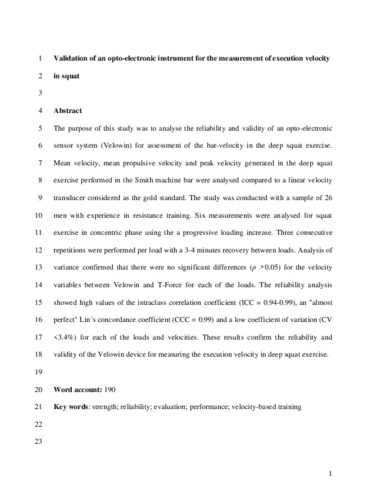Validation of an opto-electronic instrument for the measurement of execution velocity in squat exercise
Fecha de publicación:
Versión del editor:
Citación:
Descripción física:
Resumen:
The purpose of this study was to analyse the reliability and validity of an opto-electronic sensor system (Velowin) for assessment of the bar-velocity in the deep squat exercise. Mean velocity, mean propulsive velocity and peak velocity generated in the deep squat exercise performed in the Smith machine bar were analysed compared to a linear velocity transducer considered as the gold standard. The study was conducted with a sample of 26 men with experience in resistance training. Six measurements were analysed for squat exercise in concentric phase using a progressive loading increase. Three consecutive repetitions were performed per load with a 3-4 min recovery between loads. Analysis of variance confirmed that there were no significant differences (p > 0.05) for the velocity variables between Velowin and T-Force for each of the loads. The reliability analysis showed high values of the intraclass correlation coefficient (ICC = 0.94-0.99), an 'almost perfect' Lin's concordance coefficient (CCC = 0.99) and a low coefficient of variation (CV <3.4%) for each of the loads and velocities. These results confirm the reliability and validity of the Velowin device for measuring the execution velocity in deep squat exercise.
The purpose of this study was to analyse the reliability and validity of an opto-electronic sensor system (Velowin) for assessment of the bar-velocity in the deep squat exercise. Mean velocity, mean propulsive velocity and peak velocity generated in the deep squat exercise performed in the Smith machine bar were analysed compared to a linear velocity transducer considered as the gold standard. The study was conducted with a sample of 26 men with experience in resistance training. Six measurements were analysed for squat exercise in concentric phase using a progressive loading increase. Three consecutive repetitions were performed per load with a 3-4 min recovery between loads. Analysis of variance confirmed that there were no significant differences (p > 0.05) for the velocity variables between Velowin and T-Force for each of the loads. The reliability analysis showed high values of the intraclass correlation coefficient (ICC = 0.94-0.99), an 'almost perfect' Lin's concordance coefficient (CCC = 0.99) and a low coefficient of variation (CV <3.4%) for each of the loads and velocities. These results confirm the reliability and validity of the Velowin device for measuring the execution velocity in deep squat exercise.
ISSN:
Colecciones
Ficheros en el ítem



